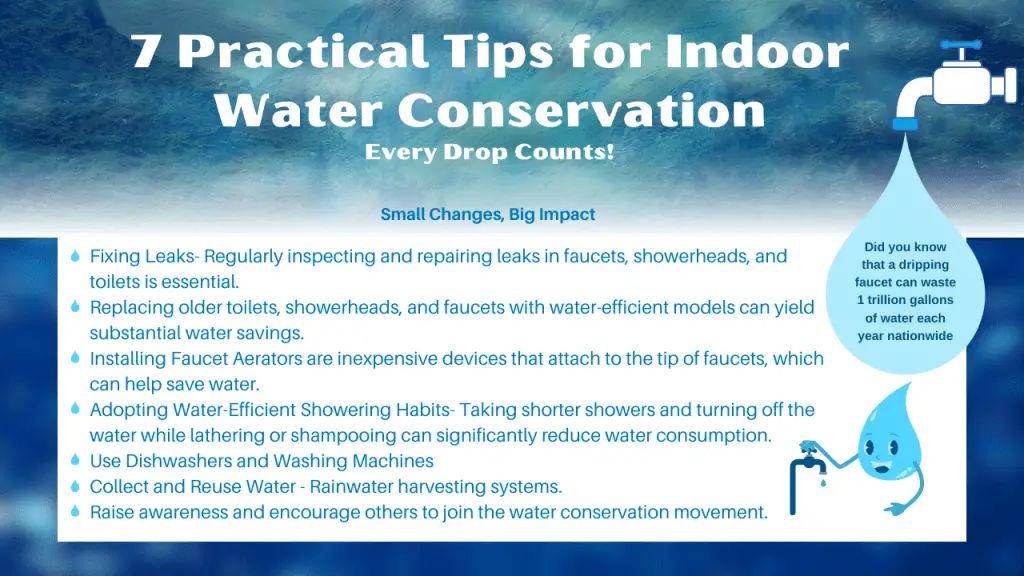Introduction:
Water is a vital resource for life, and its conservation has become increasingly essential as our global population grows every second. While water lack is a major concern in many parts of the world, we often overlook the significance of indoor water conservation.
Indoor water usage constitutes a significant portion of our overall water consumption, and by implementing simple yet effective conservation practices, we can contribute to preserving this invaluable resource. This article explores the importance of indoor water conservation, highlights key areas where water is commonly wasted indoors, and provides practical tips to promote water efficiency within our homes.
The Importance of Indoor Water Conservation:
1.1 Water as a Limited Resource Water covers approximately 71% of our planet’s surface, but only a small percentage is available as freshwater for human consumption. The world’s population grows every second, and more people need water. This is causing a shortage of water. That’s the main issue. By conserving water indoors, we can help alleviate stress on freshwater sources and ensure their sustainable availability for future generations.
1.2 Indoor water conservation is a great way to protect the environment and save resources for the future. Not only it helps the universe, but it also saves our resources for future generations.
Conserving water inside our homes directly impacts the energy required for treatment and distribution. If we use less water, it can reduce greenhouse gas emissions & mitigate the impact of climate change on the earth.
Moreover, Indoor water conservation is essential for delicate ecosystems and aquatic life. Using too much water harms these ecosystems, drains their natural water sources and causes irreversible damage to the many species that live there.
1.3 Regarding indoor water conservation, we often waste precious water in several areas in our homes without even realizing it. By identifying these common areas and taking action, we can save the environment and enjoy significant cost savings.
Furthermore, Improperly watering houseplants and gardens can waste water. Giving plants too much water harms them and causes excess water to drain unused. We may use rainwater to water or check the soil to see if it’s moist enough to prevent waste.
By addressing these common ways we waste water indoors, we can save money and help the environment. Let’s start conserving water today! Together, we can be more sustainable and save money for ourselves and future generations.
Common Areas of Indoor Water Waste:
2.1 Leaky Fixtures Leaky faucets, showerheads, and toilets are major contributors to indoor water waste. A slow drip from a faucet can waste gallons of water daily, while a leaking toilet can result in continuous water loss without immediate notice. Regularly checking and repairing these fixtures is crucial to prevent unnecessary water waste.
2.2 Inefficient Toilets Older toilet models often use excessive water for each flush, contributing to significant water waste. Upgrading to low-flow or dual-flush toilets can significantly reduce water consumption without compromising functionality.
2.3 Inefficient Showerheads Traditional showerheads can consume water per minute, leading to unnecessary waste during showers. Installing water-efficient showerheads, which provide an optimal balance of water pressure and volume, can help conserve water without sacrificing comfort.
2.4 Excessive Water Usage in Washing Machines Using outdated technology and settings that consume large amounts can contribute to water waste. Opting for high-efficiency washing machines and adjusting the load size to match the laundry’s requirements can save significant amounts of water with each cycle.
2.5 Unchecked Water Usage Habits Many individuals must realize the impact before engaging in water-wasting habits. Leaving the tap running while brushing teeth and washing dishes, taking excessively long showers, and running half-empty dishwashers are all examples of everyday activities that can waste substantial amounts of water. Raising awareness about these habits and adopting water-efficient alternatives can make a considerable difference.

7 Practical Tips for Indoor Water Conservation:
3.1 Fixing Leaks- Regularly inspecting and repairing leaks in faucets, showerheads, and toilets is essential. A small leak may seem insignificant, but the cumulative water waste over time can be significant. Promptly addressing leaks can save both water and money.
According to the EPA, household leaks waste approximately 1 trillion gallons of water each year nationwide. Therefore, during Fix a Leak Week, which will take place from March 18 to 24, 2024, efforts will be made to locate and address these drips.
3.2 Upgrading to Water-Efficient Fixtures Replacing older toilets, showerheads, and faucets with water-efficient models can lead to substantial water savings. Look for fixtures with the WaterSense label, which indicates that they meet the Environmental Protection Agency’s water efficiency standards.
3.3 Installing Faucet Aerators are inexpensive devices that attach to the tip of faucets. They introduce air into the water stream, reducing water flow without compromising functionality. Installing aerators can help save water while maintaining adequate water pressure for everyday tasks.
The EPA says that a dripping faucet can waste over three thousand gallons of water in a year. At the same time, a leaking showerhead that drips ten times every minute wastes over 500 gallons annually.
3.4 Adopting Water-Efficient Showering Habits- Taking shorter showers and turning off the water while lathering or shampooing can significantly reduce water consumption. Consider using a shower timer or playing music to limit shower time and increase awareness of water use.
3.5 Using Dishwashers and Washing Machines Efficiently When using dishwashers, wait until they are full before running a cycle. Using the appropriate settings and opting for the energy-saving mode can further minimize water usage. Similarly, adjusting washing machine settings according to the load size and opting for shorter cycles can conserve water.
3.6 Collecting and Reusing Water Collecting and reusing water can be an effective way to conserve water indoors. Rainwater harvesting systems can collect rainwater for non-potable uses, such as watering plants or cleaning. Additionally, capturing and reusing graywater from showers or sinks can provide a secondary water source for toilet flushing or outdoor irrigation.
3.7 Spreading Awareness Educating family members, friends, and communities about the importance of indoor water conservation can create a ripple effect and inspire more individuals to adopt water-efficient practices. Share information through social media, community events, or workshops to raise awareness and encourage others to join the conservation movement.
Conclusion:
Indoor water conservation is crucial in mitigating water scarcity, preserving the environment, and reducing costs for individuals and communities. By addressing areas of water waste such as leaky fixtures, inefficient toilets, excessive water usage in washing machines, and unchecked water usage habits, we can significantly impact water conservation within our homes.
By implementing practical tips like fixing leaks promptly, upgrading to water-efficient fixtures, and adopting water-efficient practices, we can contribute to a sustainable future where water remains accessible. Let us recognize the importance of indoor water conservation and take action to preserve our most precious resource for generations to come.
See Recent Article:–
Conservation and Sustainability


